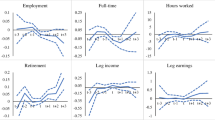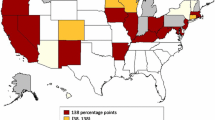Abstract
This paper investigates the effect of spousal insurance coverage on married women’s labor supply. This effect was hypothesized to be negative, since married women have an incentive to seek employment in jobs that will provide insurance when their husbands do not provide coverage. Panel data from the 1996–2004 Medical Expenditure Panel Surveys was used to control for the potential correlation between unobserved characteristics and spousal insurance. The findings suggest that spousal coverage does have a negative effect on married women’s labor supply, and that most of the reduction in labor supply seems to derive from shifts out of the labor force rather than between part-time and full-time work.
Similar content being viewed by others
Notes
Buchmueller and Valletta (1999, p. 54) specify that the component of the effect from spousal insurance that runs through unobserved heterogeneity is independent of whether women’s jobs provide insurance. This is not a strong assumption, but may be problematic if women’s jobs that offer insurance are associated not only with her working hours, but also with provisions such as flexible work schedules and paid time-off that are likely to be associated with leisure preferences. This would suggest that the effect of unobserved heterogeneity may vary depending on the insurance status of wives’ jobs.
For T = 2, as is the case here, first-differencing yields identical estimates and inference as fixed effects estimation. First-differencing was preferred in this analysis since it is easier to implement with population weighting and the complex survey design of MEPS. It also makes dealing with unobserved characteristics in the hours-worked model straightforward, as discussed in note 4.
Though geographic mobility implies that region and urban status are time-variant, the variation in these variables between time periods is negligible.
This approach is chosen because of difficulty in dealing with the c i in a Tobit model. In a standard linear regression model, the typical response to correlation between c i and the explanatory variables in a panel setting is a fixed-effects model. The fixed-effects estimator in a Tobit model, however, suffers from an incidental parameters problem. In short, treating the c i as parameters to be estimated results in inconsistent estimation of the remaining model parameters (in this case, β and γ) with \( N \to \infty \) and T fixed. See Greene (2004) for an analysis of fixed-effects and the incidental parameters problem in the Tobit model.
These effects are calculated from the formulas for marginal effects and elasticities in a Tobit model. See Wooldridge (2002), pages 522–523 for details.
References
Baydar, N., Joesch, J. M., Kieckhefer, G., Kim, H., & Greek, A. (2007). Employment behaviors of mothers who have a child with asthma. Journal of Family and Economic Issues, 28, 337–355.
Blau, F. D., & Gilleskie, D. B. (2006). Health insurance and retirement of married couples. Journal of Applied Econometrics, 21, 935–953.
Blau, F. D., & Kahn, L. M. (2007). Changes in the labor supply behavior of married women: 1980–2000. Journal of Labor Economics, 25, 393–438.
Buchmueller, T. C., & Valletta, R. G. (1999). The effect of health insurance on married female labor supply. The Journal of Human Resources, 34, 42–70.
Chou, Y. J., & Staiger, D. (2001). Health insurance and female labor supply in Taiwan. Journal of Health Economics, 20, 187–211.
Claxton, G., Gabel, J., Gil, I., Pickreign, J., Whitmore, H., Finder, B., et al. (2006). Health benefits in 2006: Premium increases moderate, enrollment in consumer-directed health plans remains modest. Health Affairs, 25, w476–w485.
Currie, J., & Madrian, B. (1999). Health, health insurance and the labor market. In D. Card & O. Ashenfelter (Eds.), Handbook of labor economics (Vol. 3c, pp. 3309–3407). Amsterdam: North Holland.
Doumas, D. M., Margolin, G., & John, R. S. (2008). Spillover patterns in single-earner couples: Work, self-care, and the marital relationship. Journal of Family and Economic Issues, 29, 55–73.
Gabel, J., Claxton, G., Holve, E., Pickreign, J., Whitmore, H., Dhont, K., et al. (2003). Health benefits in 2003: Premiums reach new thirteen-year high as employers adopt new forms of cost sharing. Health Affairs, 22, 117–126.
Greene, W. (2004). Fixed effects and bias due to the incidental parameters problem in the Tobit model. Econometric Reviews, 23, 125–147.
Gruber, J., & Hanratty, M. (1995). The labor-market effects of introducing national health insurance: Evidence from Canada. Journal of Business and Economic Statistics, 13, 163–173.
Gruber, J., & Madrian, B. C. (1995). Health insurance availability and the retirement decision. American Economic Review, 85, 938–948.
Institute of Medicine. (2004). Insuring America’s health: Principles and recommendations. Washington, DC: National Academy Press.
Jianakoplos, N. A., & Bernasek, A. (2008). Family financial risk taking when the wife earns more. Journal of Family and Economic Issues, 29, 289–306.
Johnson, R. W., Moon, M., & Davidoff, A. J. (2002). A Medicare buy-in for the near elderly: Design issues and potential effects on coverage. Retrieved from Henry J. Kaiser Family Foundation: http://www.kff.org/uninsured/6009-index.cfm
Kaiser Commission on Medicaid and the Uninsured. (2005). Health coverage in America, 2004 data update. Retrieved January 29, 2008, from the Henry J. Kaiser Family Foundation Web site: http://www.kff.org/uninsured/7415.cfm
Kalwij, A. S. (2004). A two-step first difference estimator for a panel data Tobit model under conditional mean independence assumptions (Discussion Paper 2004-67). Retrieved January 29, 2008, from Tilburg University Center Web Site: http://arno.uvt.nl/show.cgi?fid=12116
Kalwij, A. S., & Gregory, M. (2005). A panel data analysis of the effects of wages, standard hours and unionization on paid overtime work in Britain. Journal of the Royal Statistical Society, Series A, 168, 207–231.
Kim, H., & DeVaney, S. A. (2005). The selection of partial or full retirement by older workers. Journal of Family and Economic Issues, 26, 371–394.
Olson, C. A. (1998). A comparison of parametric and semiparametric estimates of the effect of spousal health insurance coverage on weekly hours worked by wives. Journal of Applied Econometrics, 13, 543–565.
Rochina-Barrachina, M. E. (1999). A new estimator for panel data sample selection models. Annales d’Economie et de Statistique, 55/56, 153–181.
Schaber, P. L., & Stum, M. S. (2007). Factors impacting group long-term care insurance enrollment decisions. Journal of Family and Economic Issues, 28, 189–205.
Sharpe, D. L., & Baker, D. L. (2007). Financial issues associated with having a child with autism. Journal of Family and Economic Issues, 28, 247–264.
Tomohara, A., & Lee, H. J. (2007). Did State Children’s Health Insurance Program affect married women’s labor supply? Journal of Family and Economic Issues, 28, 668–683.
Wellington, A. J., & Cobb-Clark, D. A. (2000). The supply-side effects of universal health coverage: what can we learn from individuals with spousal coverage? In S. Polachek (Ed.), Worker well-being: Research on labor economics (Vol. 19, pp. 315–344). Amsterdam: Elsevier.
Wilson, M. R., Harold Van Houtven, C., Stearns, S. C., & Clipp, E. C. (2007). Depression and missed work among informal caregivers of older individuals with dementia. Journal of Family and Economic Issues, 28, 684–698.
Wooldridge, J. M. (1995). Selection corrections for panel data models under conditional mean independence assumptions. Journal of Econometrics, 68, 115–132.
Wooldridge, J. M. (2002). Econometric analysis of cross section and panel data. Cambridge, MA: The MIT Press.
Author information
Authors and Affiliations
Corresponding author
Appendix
Appendix
This appendix presents the two-step procedure for estimating the censor-correction terms and parameters for Eq. 5 in the paper. For the original derivation of the model, see Kalwij (2004) or Kalwij and Gregory (2005).
Step 1: For two time periods, estimate a bivariate probit model of the form:
where W it is an indicator variable for positive work hours for individual i in time t, c i are unobserved couple-specific effects, and ε it is an error term. To model the correlation between c i and the explanatory variables, a conditional mean independence assumption is used (Rochina-Barrachina 1999; Wooldridge 1995):
where μ i is a random individual-specific error term. The function h(·) is commonly treated as the average over time, so that \( h(X_i ) = \bar X_i .\) Substituting into (1a) and (2a), the model yields:
Step 2: The bivariate model given by (4a) and (5a) is estimated to yield the predicted values \( \hat M_{i1} = X_{i1} \hat \beta + \bar X_i \hat \gamma \) and \( \hat M_{i2} = X_{i2} \hat \beta + \bar X_i \hat \gamma .\) These are used to derive the correction terms given by:
where \( \hat \rho \) is the estimated correlation between the error terms in (4a) and (5a), \( \phi ( \cdot ) \) is the standard normal density function, \( \Upphi ( \cdot ) \) is the standard normal distribution function, and \( \Upphi _2 ( \cdot ) \) is the bivariate standard normal distribution function. Given \( \Uplambda _1 (\hat M_{i1} ,\hat M_{i2} ,\hat \rho ) \) and \( \Uplambda _2 (\hat M_{i1} ,\hat M_{i2} ,\hat \rho ), \) Eq. 5 in the paper is estimated by least squares on a subset of individuals with positive working hours in both time periods:
Rights and permissions
About this article
Cite this article
Murasko, J.E. Married Women’s Labor Supply and Spousal Health Insurance Coverage in the United States: Results from Panel Data. J Fam Econ Iss 29, 391–406 (2008). https://doi.org/10.1007/s10834-008-9119-6
Published:
Issue Date:
DOI: https://doi.org/10.1007/s10834-008-9119-6




